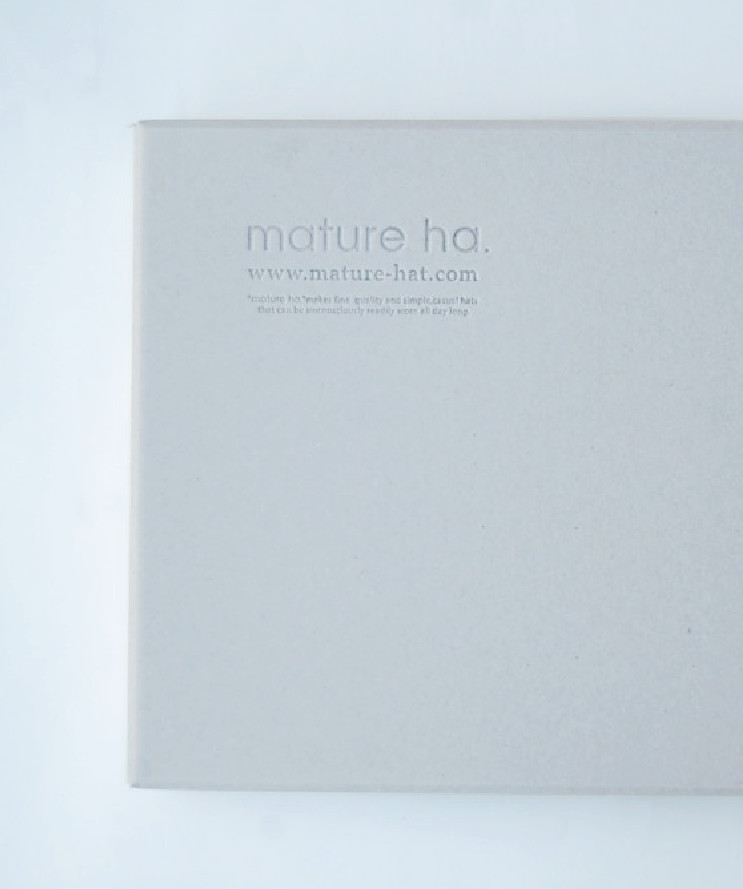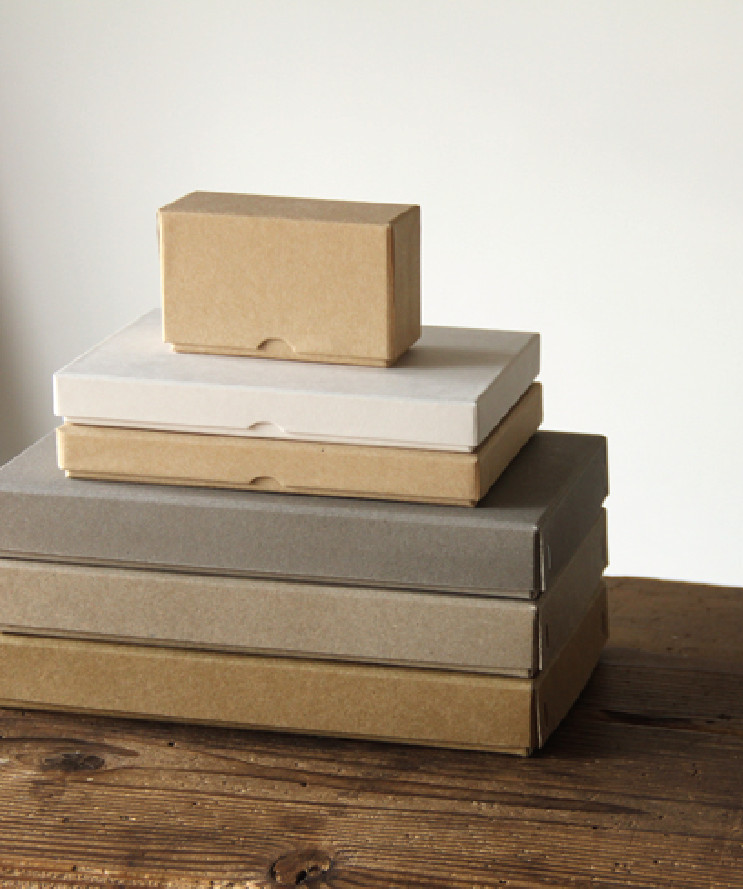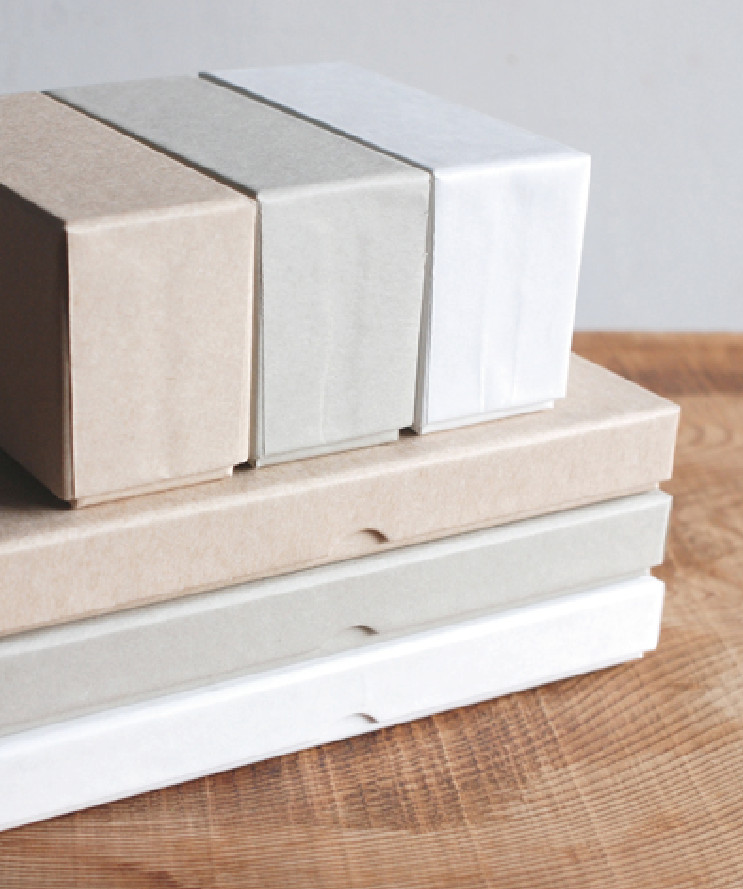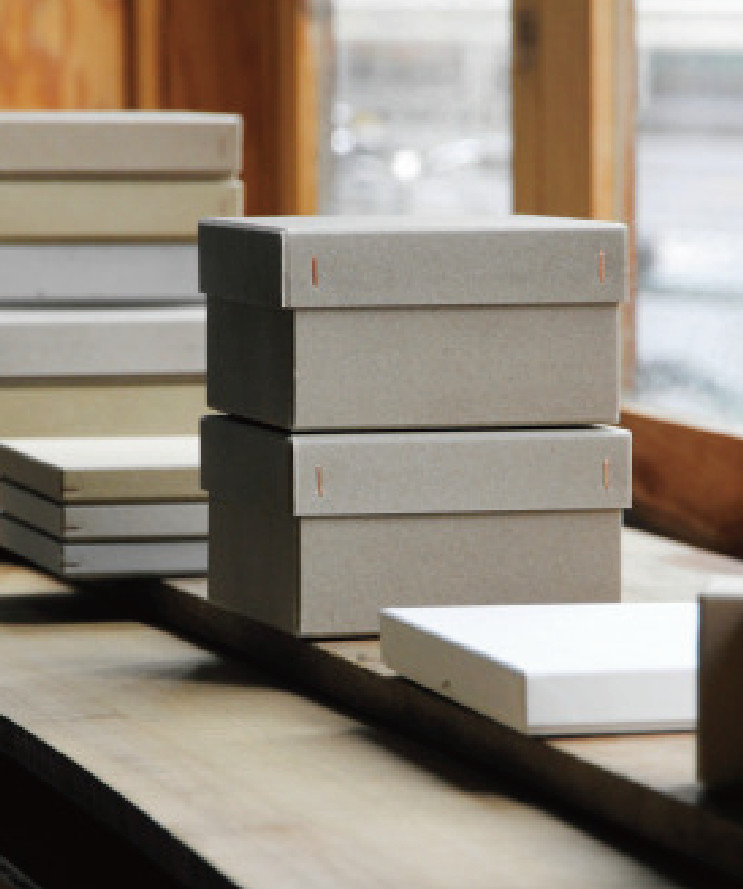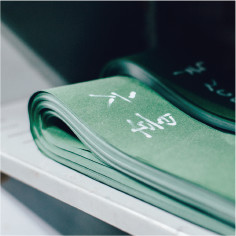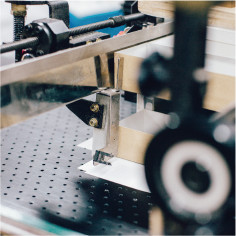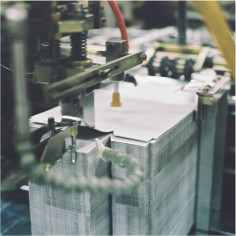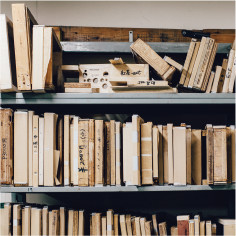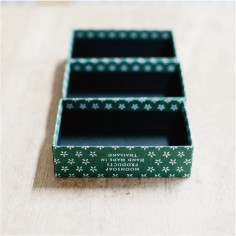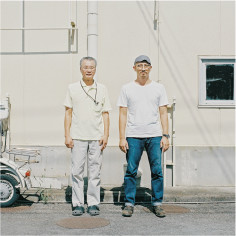TAKEUCHI PAPER CRAFTSMAN’S FACTORY
竹内紙器製作所/Paper Boxes

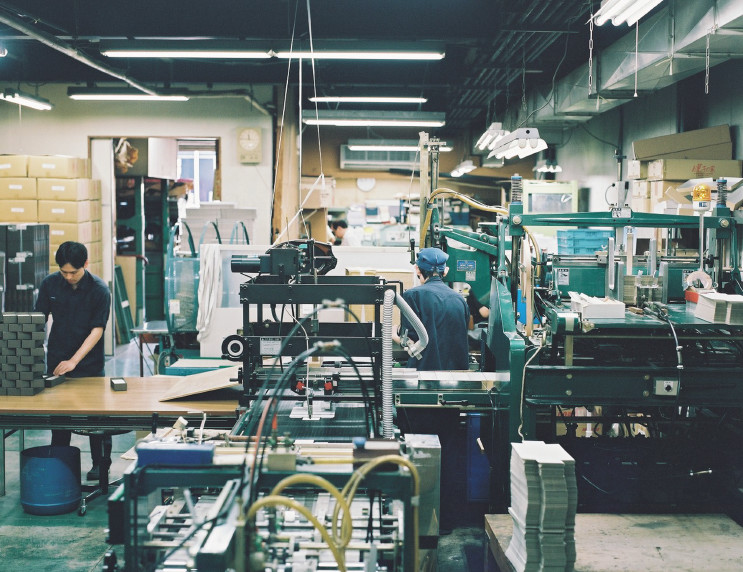
蓋を開けるその瞬間のために。
思いを伝える紙箱
重たい金属音を響かせる年代物の断裁機。無駄を極限まで省いた熟練の手業で箱を折る職人たち。紙と糊の匂いが漂う工場内には、ぴんと張り詰めた静謐な気配がある。横浜市金沢区にある竹内紙器製作所は、1948年の創業当時から続く貼箱や平留めの紙箱の製造、凸版や箔押し、シール印刷を行う製造会社だ。この老舗の製箱会社から生み出される紙箱が、手づくりにこだわるブランドや個人の作家から注目を浴びている。“今”の手触りをまとった無骨で美しい佇まい。単体でプロダクトとして成立するようなオリジナルな存在感をまとう竹内紙器の紙箱は、PAPIER LABO.、F/style、YAECA、CLASKAをはじめとした若く鋭い審美眼を持つクライアントとともに生み出されてきた。職人らしい大きな握手で私たちを迎えてくれたのは竹内紙器製作所の将来を担う次期三代目の堀木淳一さん。「製造業の在り方を根本から変えたい」。新しいものを生み出すためには、ときに重くなりがちな“老舗”の看板にも、果敢な挑戦心と、ものづくりへの真摯な姿勢で向き合ってきた。現場で戦い続ける製箱職人、堀木さんにお話をうかがった。
An old cutting machine is making a heavy metallic sound while craftsmen are folding boxes by skillful handwork with no wasted motion; the factory is full of calm and tense atmosphere with a smell of paper and glue. Takeuchi Paper Craftsman's Factory, located in Kanazawa Ward in Yokohama, was founded in 1948. Since then, they have been making rigid paper boxes and straight-stapled boxes as well as letterpress, foil stamp, and sticker printing. Now, those paper boxes created by this long-established factory are attracting brands and creators who want distinctive handwork. Their modern, simple yet beautiful paper boxes, which can be recognized as products themselves, have been created in collaboration with young and energetic clients such as PAPIER LABO., F/style, YAECA and CLASKA. Mr Jyunichi Horiki, the next third-generation president, welcomed us with a craftsman-like big handshake. He has faced with severe reputation, typical of long-established stores or companies, with his challenging spirit and sincere craftsmanship in order to create new values and to drastically change the situation of the manufacturing business. We interviewed Mr Horiki, a paper box craftsman who has been striving on the spot of manufacturing.
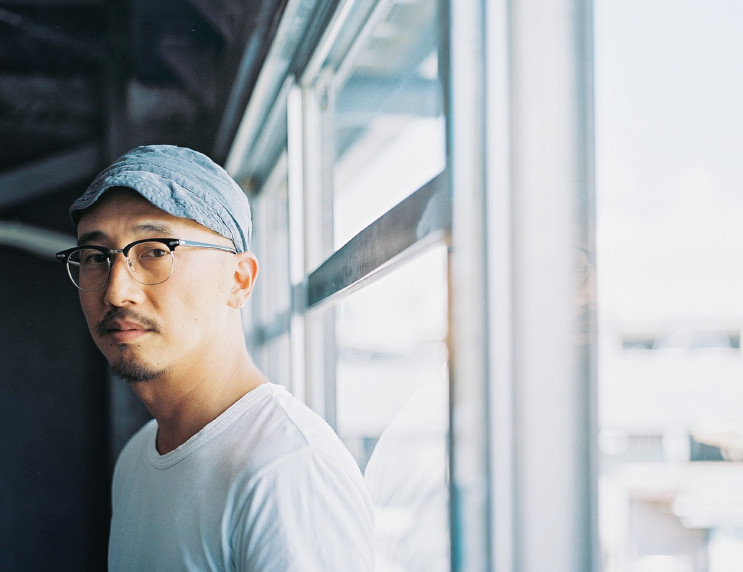
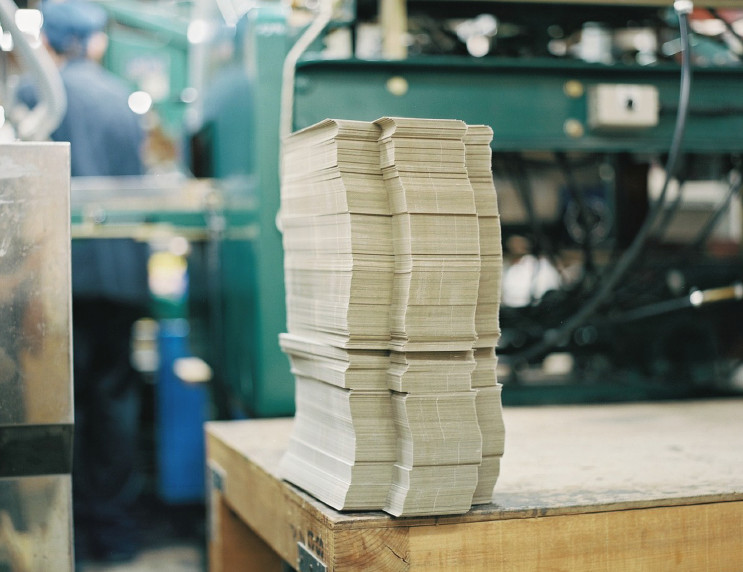
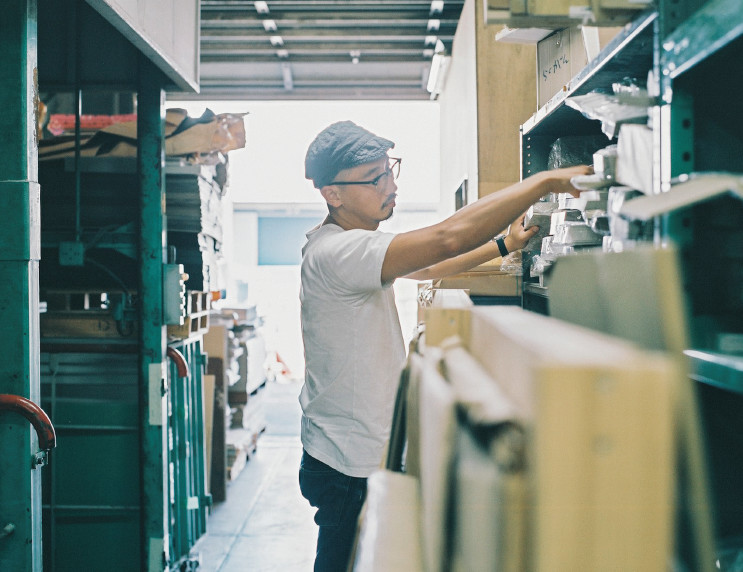
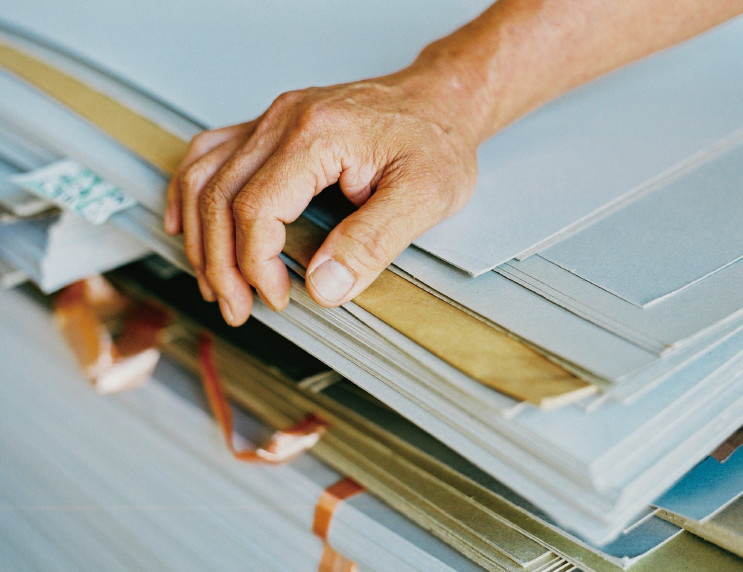
気持ちが伝わる箱
- 堀木さんが、今のようなオリジナルの紙箱を
作るようになった経緯を教えてください。 - 入社当時は主にシール印刷の現場を回していたんです。その頃から旧態依然とした製造業の在り方にずっと不満を抱えていました。そろそろこの大量生産の流れは違うなって。だけど当時の僕は、社長を説得するための材料は何も持ち合わせていなかった。その結果として大量生産できるシールの印刷機を新たに導入し、朝から夜遅くまで印刷機を回す日々が続きました。シールの生産過程にはゴミが結構出るんですよ。カスと呼ばれる不要な部分などがたくさんあって。夜中まで延々機械を回して印刷して、納品した次の日には捨てられる。そんなことを繰り返しているうちに、「こんなにゴミを作って、いったい俺は何をやっているんだろう」。そんなふうに結構へこんでましたね。いつも心の中が侘しさがありました。あとその時期にすごくカチンとくることが何度かあって、製造業はなんでこんなに下にみられるのかと。「製造業をなめるな」っていう思いが強くなるほど、このままではダメなんだということに気付かされました。 そんなとき、転機のような出来事があって。あるとき、嫁さんの誕生日が迫ってきていて、ほんと久し振りに何かプレゼントしようと思ったんですね。で、考えたのが小さなアクセサリーを、大きな箱に入れて渡そうと。もらったら、なんだこの箱って思うでしょ。で、開けたら小っさなものが入っている。そのちょっとした驚きというか、楽しみというか。初めて箱を通して渡す相手のことを考えたんです。社長に頼んでその箱を作ってもらいました。ちょっと恥ずかしいんですが、そのときに初めて、箱って人の気持ちを伝えることのできるツールなんだなと心から思えたんです。それだったら、僕は箱を作っていこうという気になったんです。
- Tell us how you started making your original paper boxes.
- When I joined this company, I was mainly in the sticker printing site. Since then, I've been discontent with the obsolete system of the business and the trend of mass production. But I had nothing with me at that time to persuade the president to change the situation. As a result, a new printer was introduced for the mass production, and we kept operating the machine from early in the morning till late at night. Actually, we get quite a lot of waste in making stickers, because of the unnecessary parts and others. We kept operating the machine till midnight, delivering, and throwing the waste away. While repeating such things, I got rather depressed about producing so much waste. I think I was feeling some sort of emptiness all the time. Also, several unpleasant things happened that irritated me a lot, being treated as a lower class. The more strongly I wished to raise the social status of the manufacturing business, the more clearly I realized that we must change ourselves first. Then, there was some kind of turning point. One day, I thought of giving a birthday present to my wife for the first time after a long time. The idea was to put a small accessory in a big box. You know, as a little surprise or fun. It was the first experience for me to think about someone with a box. I asked the president to make that box for me. It is a bit embarrassing to say, but it was the very first time when I could convince myself that boxes are communication tools that can send messages. Then I made up my mind to make boxes.

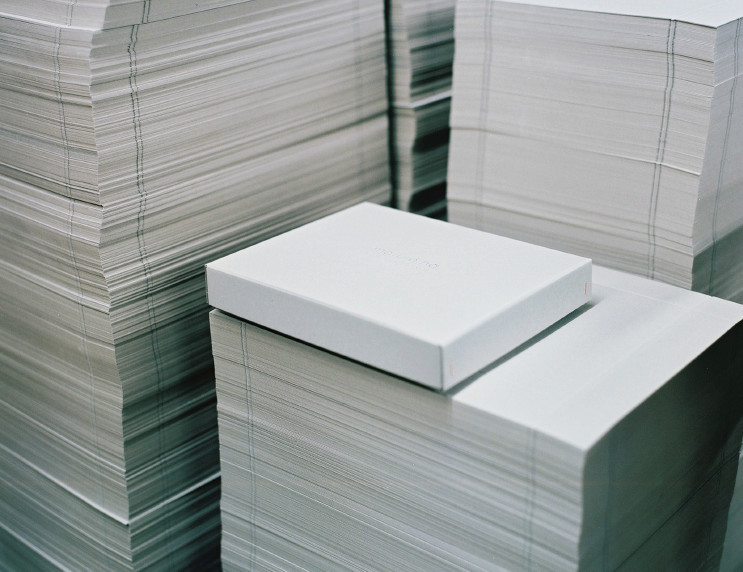
- 竹内紙器は創業当時から貼箱や平針の箱を製造していますが、
堀木さんはどんな箱を作りたかったのですか。 - 実はもともとうちで作っていた箱が、あまり好きではなくて(笑)。だからまずは自分が本当に好きな箱を作ろうと、既存の箱の仕様にはない板紙や紙を探し始めました。そうすると、ものづくりに対する考え方も変わってくるんです。たとえ一個からでも、箱を作りたいというお客さんがいたら、それに応えていきたい。その人にとって大切なものを形にしたいと。どうせものづくりをやっていくなら、その思いに応えていくことに意義があると思ったし、進むべき道が見えてくるように思えたんです。
- とはいえ従来のやり方を変えるには、
強い思いというか覚悟が必要だったのではないでしょうか。 - そのとき大きな衝動として、製造業の底力を信じたい、見返したいという気持ちが強くありました。そのためには、自分たちでないとできない仕事をやっていくことが大切だと思いました。その責任を背負うことで、これだけのものを作るためには、これだけかかるということを主張していけるようになると思うんです。そうじゃないと、製造業はどんどん苦しくなっていくばかりですし、続かない。 次に、箱を作るんだったら、一個ずつ大切に作っていきたいという思いがありました。そのやり方として、製造側の都合を通すのではなく、お客さんの思いを拾い上げることが大事だと気付いたんです。それならこういったものができますよ。という提案型に切り替えていくのが正解だなと。その結果として、箱を通じて思いを届けることができると。そんな確信が頭の中にあったんです。
- リスクや障害は? シールの現場も回さないといけない。
- それまで二人三脚でシール印刷の現場を回していた今の工場長に現場を任せ、おかげで僕が動き回ることができました。でもそれは、やはり社長の理解があったからできたことですね。僕のやりたいことを理解して信じてくれた。自由にさせてくれたんです。
- Since establishment, Takeuchi Paper Craftsman's Factory has been making rigid
boxes and straight-stapled boxes. What kind of boxes did you wish to make? - Actually, I haven't liked those boxes made by my factory very much. So, in order to make my favorite box, first I started to search for unique cardboard and paper. Then, I noticed that my view toward manufacturing changed. I gradually became to feel that I want to respond to my client's request no matter how small the order is and to realize what is important for the client. I thought it must be meaningful and I would find a way to follow as a craftsman in doing so.
- Still, didn't it require a strong will or determination to change a conventional way?
- As a big motivation, I simply wanted to believe the power of manufacturing business and prove it. And I thought what is important for us is to do what nobody else can do. By being responsible for that, I think I could become confident in presenting the price to the client, even under the present circumstances where anything can be made at low cost overseas. This must be the only way to survive for the manufacturing business, to be responsible and to be confident. I also wanted to make each box carefully. In order to do so, I found that we should be aware of the clients' needs, not our own convenience. This is why I changed my sales style to a proposal type. I was certain that we would be able to send our messages through boxes by following this way.
- Any risks or obstacles?
You were also in charge of sticker printing besides box making. - By leaving sticker printing site to the present factory manager, I could do my own job, of course with the understanding of the president. He understood me and trusted me. He let me do freely.
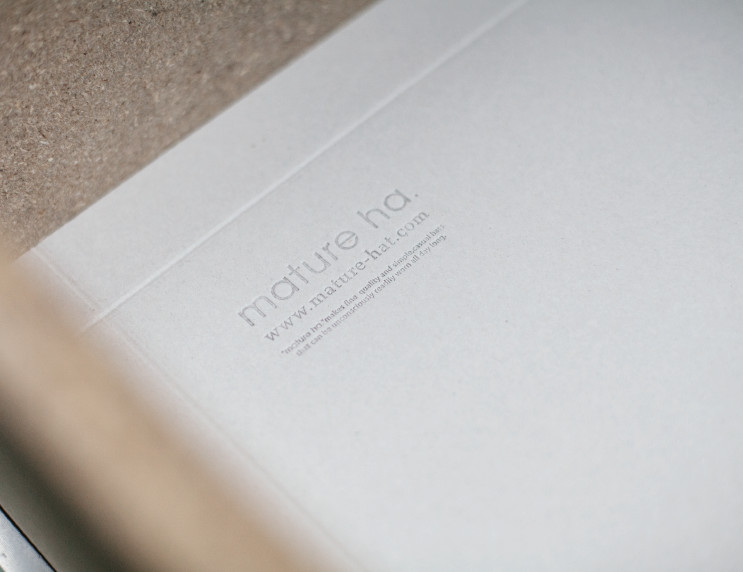
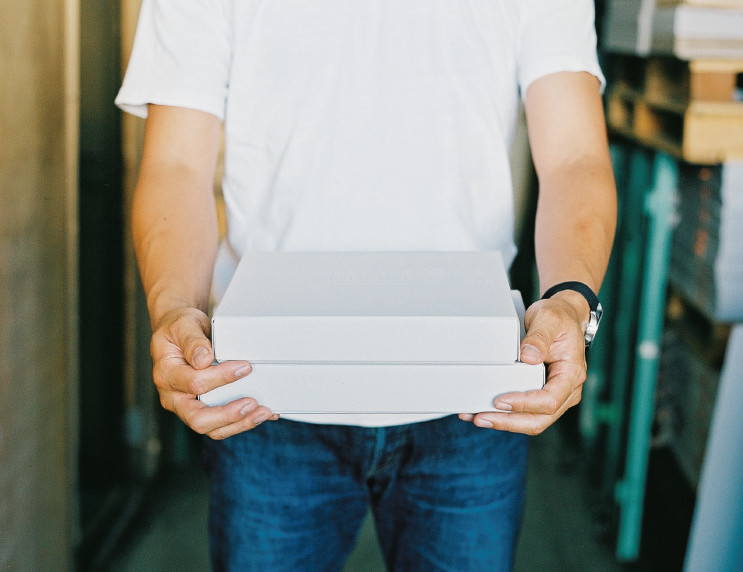
新しい出会い。新しい箱づくり
- 最初の仕事は、PAPIER LABO.さんだったとのことですが、
どんな経緯があったんですか。 - 当時オンラインショップの黎明期だったこともあって、これから何でもインターネットで買う時代が来る。そんな時代だからこそ、お客さんがお店に来て、相談できるような仕組みを作りたいと考えていたんです。そのときにイメージしたのが古着屋さんでした。古着ってお店に行かないとわからないじゃないですか。紙も一緒で、当時僕が集めていた海外のユーズドの印刷物の破れ感なんかは実際に手に取ってみないとわからない。そんな紙を使って箱や印刷物を作るために相談できる窓口のようなものがあったら良いかもって思ったんですね。それであちこちリサーチをしていると、理想的なかたちを実現していたのがPAPIER LABO.さんだったんです。紙を前面に出してプロダクトを作って。正直、紙の部分で重なっていたこともあって、ちょっともういいかなって冷めちゃって…。
- やろうとしてたことが、理想的な形ですでに完成していた。
- そう。それで、その年の夏休みに普通に客として遊びに行ったんです。お店として面白そうだなって。そしたら代表の江藤さんと紙の話で盛り上がっちゃって。海外で見つけた雑な質感の紙が好きなところとか、趣味趣向が驚くほど近くて楽しかった。で、何やってるんですか?って話になって、箱作ってますって。それから箱を作りたいっていう話をいただいたんです。今の竹内紙器の箱づくりの流れが始まったのはそこからですね。
- 箱の製作はどんなプロセスで進めているんですか?
- クライアントによって様々ですが、例えばPAPIER LABO.さんとのときは、こういう箱を作りたいという具体的な要望をもとに製作しました。一方、新潟のF/styleさんを例に出すと、純粋に箱をプロダクトとして作りたい。っていうのがスタートだったんです。こちからから自由に提案させてもらいました。
- 自由。それが一番難しいお題かもしれませんね。
- 自由といっても、ゼロから作るわけではありません。F/styleの展示会に足を運び、その空間から得たイメージと、おふたりから直に聞き出したイメージをもとに、紙の仕様や形、サイズを導き出しました。それまで自分が集めていた紙の中からセレクトしてサンプルを製作してご提案しました。
- 具体的にはどんな提案を?
- 黄ボールっていう板紙にハーフエアのヘンプ紙を貼ったタイプの貼箱を提案しました。従来の貼箱に使う板紙の白さが好きになれなかったので、そこにクラフト系の黄ボールを使ったのがポイントですね。依頼を受けた展示会場から戻ってくるなり、社長にこうこうこんな感じのサンプルを作ってほしいとお願いすると、すぐに作ってくれました。それを持って次の日に銀座松屋の展示会場まで提案に向かいました。
- 翌日!ずいぶん早い提案ですね。
- そう。おふたりのイメージにあう箱ができたことで、早く見ていただきたい、その一心でした。おふたりには、ひと目見てサンプルを気に入っていただけました。とても嬉しかったですね。納品のときもどうしても自分で持っていきたい、という思いがあって、社長に頭を下げて新潟まで12時間くらいかけて車で向かいました。大切な出会いが重なったこと、それまで積み重なった思い、そんなことが自然と体を動かしたんだと思います。
- なにか、ものづくりの原点的な衝動と、熱のようなものを感じます。
- 従来の箱づくりでは、いつも使っている板紙、いつも使っている紙、その中でこういうのはどうですかっていう提案の仕方が主流なんです。僕はそれを変えたかった。一番大事なのは箱の中に入る商品ではあるけど、それが箱に収まり棚に並んだときの佇まいをイメージできるかが大切です。箱が主張するのではなく、商品の魅力を引き立てることに意識して。魅力的な佇まいであるか、手にとってみたくなるか。それが成功したときに、パッケージの力に気づいてもらえればいい。この仕事で経験したことはその後のものづくりの考え方に大きく影響しています。
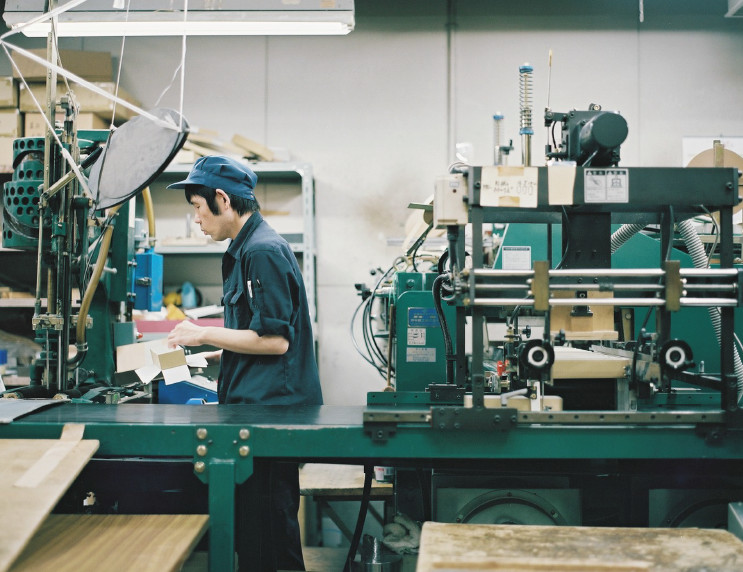
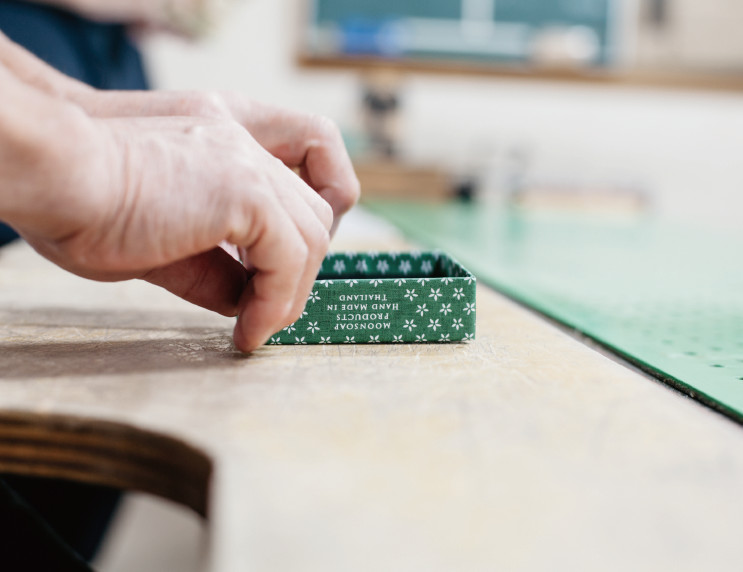
- Your first client was PAPIER LABO. How did it come about?
- At that time, online shops were about to emerge. In the Age of the Internet where you can buy anything online, I wanted to make a system that customers can actually visit a shop to discuss with staff face to face. A vintage clothing shop was my image. We can't check the condition of the clothes without actually visiting the shop, can we? It's just like so with paper. You can't confirm how the foreign used printed matters in my collection were aged if you don't actually touch them. So I thought it would be a good idea to make something like a consulting service counter to order boxes or printed products using such paper. In doing some research, however, I found that PAPIER LABO. had already realized it, highlighting paper products. To be honest, I got kind of depressed to know that.
- What you were trying to start had already been realized in an ideal form.
- Right. So I visited PAPIER LABO. as a customer, not as a researcher, during my summer vacation that year because the shop was simply interesting to me. There, quite unexpectedly, I enjoyed chatting about paper with Mr Eto, the representative. We had surprisingly similar tastes in paper, such as the rough texture of foreign paper. He asked me what my job was, and I told him that I was making boxes. That was how Mr Eto ordered us to make boxes, and how our trend of box making began.
- What is the process of your box making?
- It depends on the client. In case of PAPIER LABO., for example, we made boxes based on the client's specific plan. In case of F/style in Niigata, on the other hand, it started from a simple request to make boxes purely as products. They let us propose our ideas freely.
- Freely. That may be the most difficult request, isn't it?
- But it was not from nothing. I went to their exhibition and derived the specification, shape and size from the inspiration I got from the space and image I heard directly from the owners. Then, I proposed a sample using paper from my collection.
- What kind of proposal was that?
- It was a rigid box using yellow cardboard glued together with hemp fine paper called “half-air”. I don't like white cardboard usually used for rigid boxes, so I used yellow craft cardboard instead. As soon as I got back to my factory from the exhibition, I asked the president to make a sample, and he did it for me on the spot. Next day, I visited their exhibition in Matsuya Ginza, a department store in Tokyo, with the sample for proposal.
- Next day! How quick!
- I know. I just wanted to show the box as soon as possible because I was quite confident that I was able to make a box exactly to their image. Happily enough, they liked the sample at first sight. When the products were made, I wanted to deliver them by myself. So I asked the president for the permission and went all the way to Niigata by car, taking 12 hours. I think precious encounters and accrued passion in myself naturally made me do so.
- I feel some kind of basic impulse or energy for manufacturing from you.
- In the conventional box making business, the mainstream is to propose samples using usual cardboard and usual paper. I wanted to change that. Of course, what is most important is the item in the box. But when the item is packaged in the box and displayed on a shelf, it should be attractive enough for the customers to reach out their hands, being not too showy but setting off the item. When those things go well, I hope people will find the power of packaging. My experience with F/style has influenced me a lot since then.
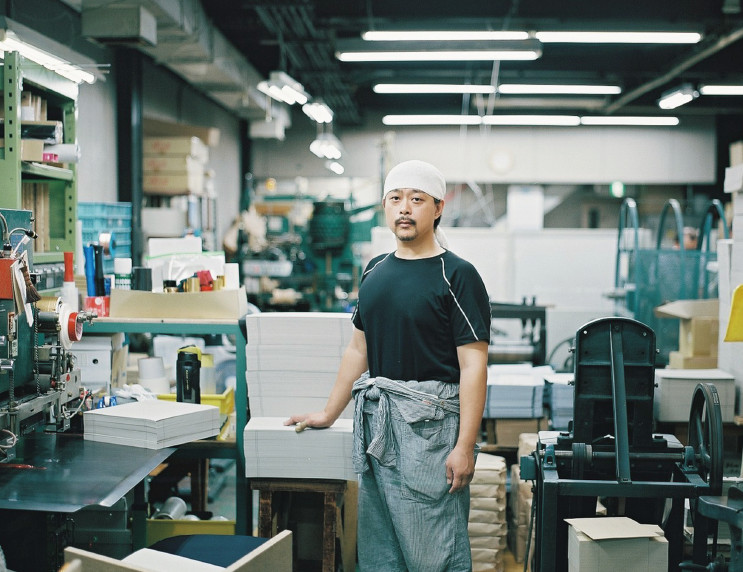
“採算”は敵か味方か
- ひとつひとつ丁寧につくること。理想的ではあるけれど、
ビジネスとして捉えたときに成立するものでしょうか。 - 製造側がクライアントに、これだけコストがかかるからこの値段だと言える環境がないと成立しません。その面で現実的にはまだまだ厳しい。僕はそこをまず打破したいと思っています。そのためには、商品を買いに来る消費者に対して、なぜその金額なのか、納得してもらえる価値を提示したうえで、買ってもらえる循環を作っていかないといけない。 そのためには従来の固定概念を覆してしていく必要があります。例えばmature ha.さんのBoxed Hatで採用していただいているホチキス留めの紙箱にしても、もっと安くできるところは他にいくらでもあります。昔の世代ではもともとこれを雑箱と呼んでいて、その名の通り雑に作っていた箱だったわけです。そういった既存の考え方を製造業側から変えていかないと先はないと思います。 例えばホチキス留めにしても、うちのやり方では、ひとつずつ足踏みしながら留めていきます。身と蓋で8箇所、2万個作るのならば16万回足踏みする。単純な作業だけど、これを外部の業者を使わずに工場長や僕ら職人が手作業でやっているのには、そこに譲れないこだわりがあるからなんです。他では考えられないやり方だと思う。人件費換算で言えば、本当に効率の悪いやり方かもしれないけど、そこをけちってしまうと、今までやってきたことを無駄にしてしまうことになる。バカだと思われるかもしれないけど、絶対譲れない部分なんです。理想はまだ先にありますが、一歩ずつ近づいていければと思っています。
- To make each item carefully.
It must be the ideal but could it be approved as a business? - What is essential for us manufacturers is to have proper relationship with the clients so that we can be confident about the cost and the price. In reality, the situation is still very hard. I want to break it through first. In order to do that, I need to create a good cycle with the consumers; explain the price, gain their understanding about the value, and have the merchandise purchased.
So I need to change the conventional stereotype. For example, old generation called a stapled paper box, the one used for Boxed Hat by mature ha., “a rough box” and they actually made it roughly. Even today, many other factories can make it much cheaper than us. Such way of conventional thinking should be changed from our side.
For instance, we step on each part by foot to staple. We have to staple 8 parts for a set of a box and a cover, which means 160,000 stepping works for 20,000 boxes. It is simple work, but we stick to do that ourselves by handwork, not by outsourcing. Nobody would do in such way nowadays because of the labor cost and inefficiency. But we should not and cannot waste our experience and history. We may look silly, but we must stick to it. The ideal is still far ahead, but I hope to step forward little by little.
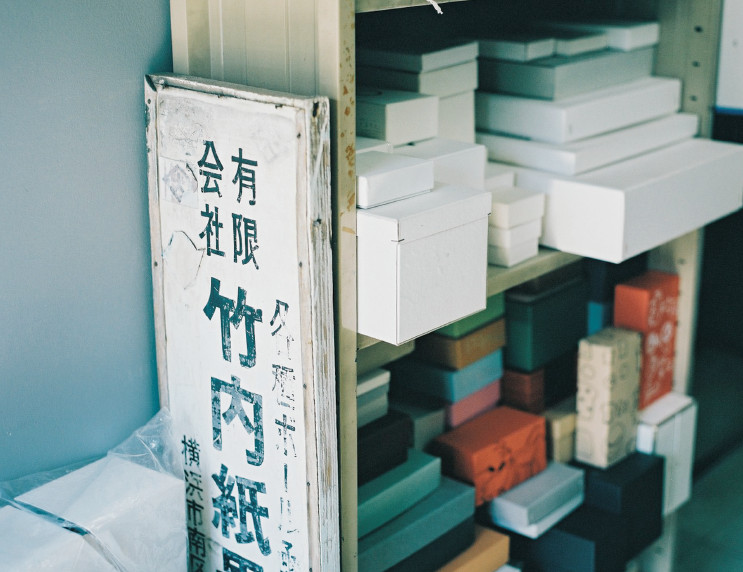

PROFILE
貼箱・平留の紙箱、凸版・箔押し・シール印刷の製造会社。“オペレーター”ではなく“職人”として物作りに取組む。
A manufacturing company of rigid paper boxes, straight-stapled boxes, letterpress, foil stamp, and sticker print. They strive for manufacturing as “craftsmen” not as “operators”
